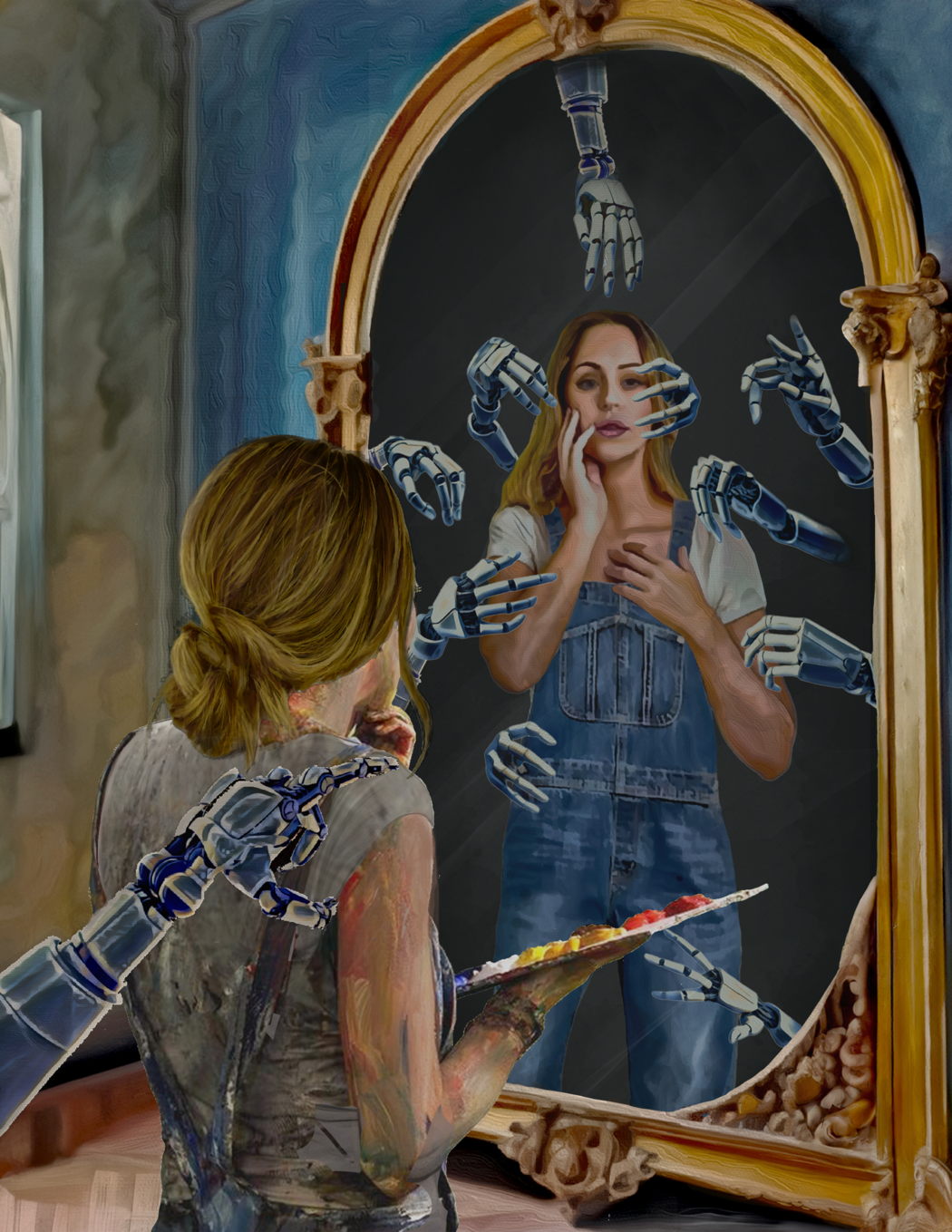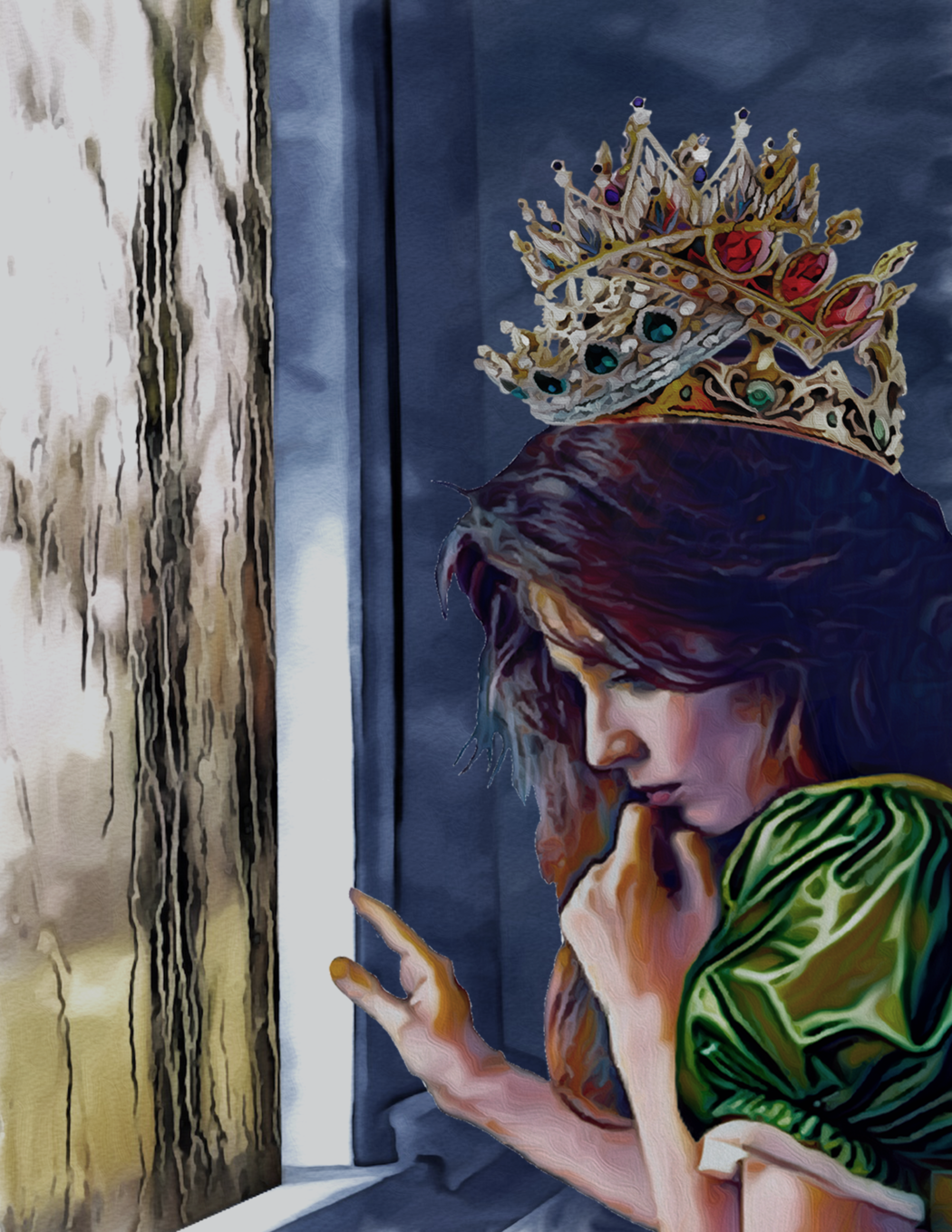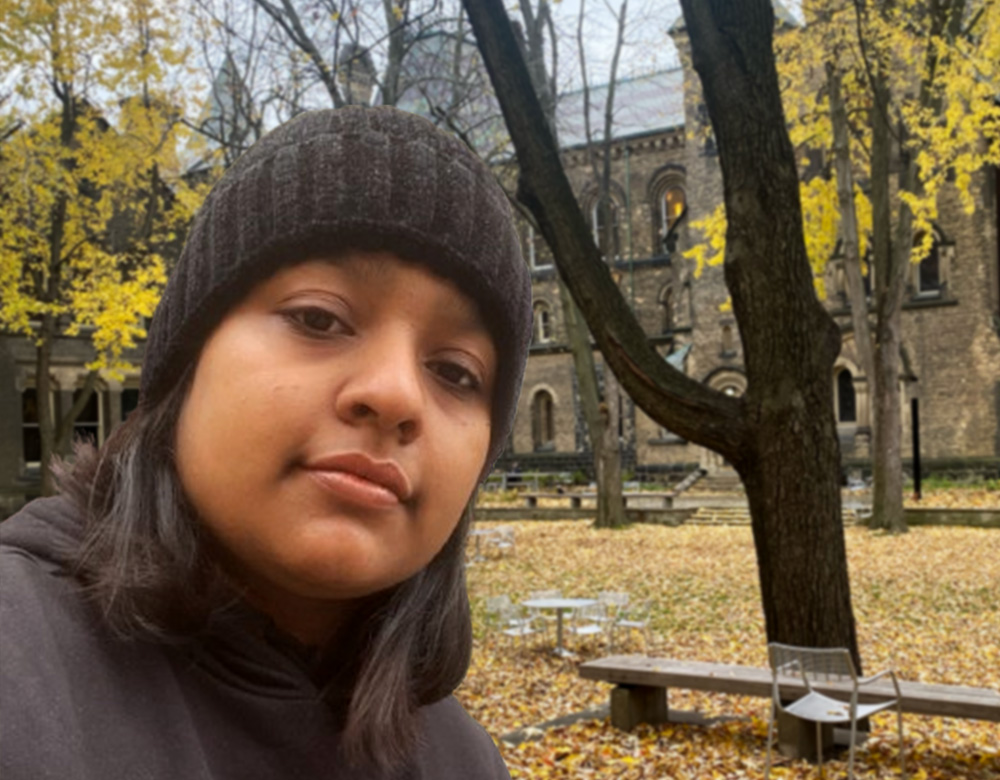Sakira Siamina Rimlee
Year of birth: 2000.
Where do you live: Toronto, ON, Canada.
Your education: Bachelor of Arts: Architecture, Landscape and Urbanism, University of Toronto.
Describe your art in three words: reflective, responsive, confrontational.
Your discipline: Acrylic and Mixed Media on Canvas, Digital Collage and Mixed Media Art, Sculpture, 3D Modelling, Film-making and Cinematography.
Website | Instagram
Your work “Soliloquy” touches on the contemporary discussions surrounding AI-generated art. Could you elaborate on what inspired this particular piece and the message you wish to convey?
As suggested by its name, ‘Soliloquy’ is the by-product of my inner reflection. It responds to the pivotal changes in artistic production brought about by AI. It attempts to capture my personal dilemma regarding the ethical integration of AI generative art in image-making, invoked by casual conversations in the university cafeteria with friends and contemporaries, who, much like myself, have been grappling with this ‘new normal’ of visual communication. However, when viewed against the larger backdrop of ongoing discussions within the contemporary art community, especially regarding the unlawful copying of artistic gestures emulated by these generative tools, ‘Soliloquy’ transcends its original purpose. It becomes a mirror unto itself. The work aims to represent the two sides of the debate on a singular picture plane. It features a duality of helpful reliance and overbearing devaluation of individual artistic rigor prompted by generative media. It is left up to the viewer to decide which side of the ‘mirror’ they begin interpreting the work from. In doing so, they introduce their own bias by picking a side.
Having a background in both architecture and graphic design, how do you feel these disciplines influence your creative process and artistic expression?
Being in architecture school has vastly impacted my preliminary process of formulating a composition. While I have been a lifelong art enthusiast, being actively involved in design-oriented thinking has changed the way I approach worldbuilding in my artistic explorations. Architecture and graphic design largely involve thinking through layers. In recent times, my focus has therefore shifted from thinking firstly about the subject of the drawing. Instead, I now focus on the spatial organization of the backdrop. Once the backdrop is well-oriented in my imagination, I am then able to easily translate it onto my digital canvas. In my opinion, this approach provides more clarity moving forward, making the process of adding and subtracting in collage/mixed media-based pieces much easier. The resulting works end up having a better balance of spatial elements, combined with color, texture, light, and shadow. Working together, these components help accentuate the emotive quality of the artwork. They communicate the broader themes encircling the subject more effectively.
 Sakira Rimlee | Soliloquy | 2024
Sakira Rimlee | Soliloquy | 2024
You have worked with various media throughout your career, from acrylics on canvas to digital mixed media. What motivated your transition towards digital art, and how do you see this medium shaping your future work?
I feel like operating within a design school for the past four years had a lot of influence in terms of this transition. As I harbored technical skills in Adobe CC and other design software, producing digital drawings and mixed media art helped broaden my artistic vocabulary. Both from a creative as well as an economical point of view, I found digital works to be incredibly exciting. Not only did this shift allow me to move from ‘representative’ art to ‘reflective’ art, but it also minimized the necessity for physical tools such as paints and brushes, which can be pretty costly and sometimes even wasteful. I would say that the transition from physical to digital art definitely helped me put on my sustainability hat beyond the realms of architecture. With this newfound love for digital image-making, I am currently delving deeper into experimentation with various software. I believe that refining both the techniques of producing digital art, along with the content itself, would help make my works more versatile in the future.
“Soliloquy” presents a duality of comfort and anxiety. Can you share more about how you personally experience this duality when creating art in the age of AI technology?
As mentioned earlier, ‘Soliloquy’ is definitely a product of self-reflection. For someone like me who experiments a lot with digital collage and mixed media, AI can prove to be a very seductive form of technology. I have had my fair share of experience inserting my preliminary sketches and/or written prompts into generative media to help feed my curiosity. Though none of the generated imagery came out exactly as I envisioned them, they did help me organize my thoughts and ideas better. However, I couldn’t shrug off this persistent feeling of guilt as I carried on with this process. I feared that I would become overly indulgent in using AI to accelerate the process of artistic production, or the final works wouldn’t be too far removed from the guidelines that I had generated. ‘Soliloquy’ bears signs of this very anxiety.
Be that as it may, I am happy to report that I came up with a better way to integrate AI into my practice down the line. As found imagery often serves as the building block for collage-based art, I have started using generative tools to formulate minor components of my art, which are otherwise difficult to come across. Once generated, these elements are oriented and transformed through manual intervention before being paired up with other found, collected, or captured media to create a piece. I find this practice to be more morally and visually ethical, in a similar vein to traditional collage-making.
 Sakira Rimlee | Heavy is the Crown | 2024
Sakira Rimlee | Heavy is the Crown | 2024
Your work often reflects societal changes and personal growth. How do you integrate these themes into your art, and how has your artistic voice evolved over time?
When working with reflective or commentative themes, I usually incline towards conjuring up a new character each time I work on a project. These characters tend to view the world through a lens they share with me. This helps me respond to ongoing social and cultural phenomena in a tone aligned with my inner voice. It is a tactic that is very similar to filmmaking, except that instead of a moving image, the story/narrative is communicated through capturing a singular moment in time.
As for the evolution of my artistic voice, I would say that it has gone through a major shift since I started working on more digital projects. Before this shift, much of the work I would make would be strictly representative in nature. I would surf the internet for hours trying to find references that allowed me to experiment with different painting media, texture, and color. But nowadays, I am more interested in making art that is inward-looking. I use it as an outlet to process my own thoughts and feelings.
In your view, what role should human creativity play in a world where AI is increasingly involved in generating art?
Even before the advent of AI, I never really believed in the idea of a ‘singular creative genius’ of an artist or an artwork. In my eyes, no art that has ever been created is devoid of worldly inspiration, no matter how otherworldly it looks. Art functions much like a person’s dreams. In this sense, as a practitioner of art, I take little issue with AI drawing ‘inspiration’ from other people’s work. What I do not stand for is unethical ripping off and mimicry of another artist without any kind of acknowledgment.
While there has been much upheaval in the art community regarding this topic, my opinion is that holding the ‘tool’ at fault does no good at all. I feel like artists should have more first-hand involvement in shaping AI itself. That way, human creativity can still take the lead in refining the tool, training AI to be more ethical and useful to artists as well as the larger society. If that means art would become even more accessible to wider masses, I see no problem with that. I believe there’s plenty of room for all of us.
You draw inspiration from both urban landscapes and natural settings. How do these contrasting environments influence your art, and do you find a balance between them in your creative process?
As an architectural designer, I have come to understand urban landscapes and natural settings as two sides of a coin, which, though contrasting, cannot exist without one another. I try to implement the same ideology when portraying urban and natural settings in artistic representations.
Most of the time, my works feature one or both of these types of landscapes as a secondary character. I draw inspiration from travels and everyday scenes or even from photographs and videos that I capture on the go. I think that the rendering of both these highly distinctive scapes is crucial to my creative process, in that they help carry the narrative of the work by catering to its atmospheric quality and mood. The landscapes serve as a mediatory tool, bridging the gap between the artist’s intent and the interpretation made by the viewer.
While striking a good balance can be quite tricky at times, I would say that the content of a specific artwork influences the choice between urban and rural scenes very early on in the process. Even in this sense, the landscape and the subject matter simply feed into each other.


Abrar Hossain
An actually interesting article. Worth the read. 10/10